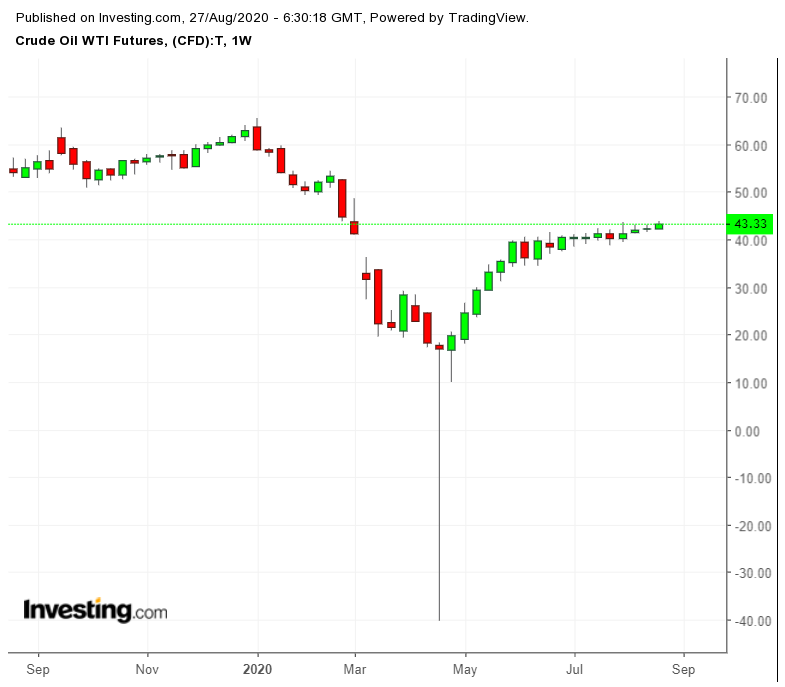The good news for oil prices: U.S. petroleum inventories are continuing to decline.
EIA data released on Wednesday revealed another significant draw in both crude oil and gasoline inventories. The bad news for oil prices is that the market isn’t reacting strongly to the announcement. WTI inched up a bit but remained mostly steady at around $43 per barrel.

Despite seeing drawdowns for over a month, crude oil inventories are still 15% above the 5-year average and gasoline inventories remain 5% above the 5-year average.
In addition, demand outlook hasn’t improved. In fact, major forecasting institutions recently revised their demand predictions to the downside—more in line with what this column has been warning—as they realize that the recovery from the global pandemic and economic shutdowns isn’t progressing as quickly as hoped.
Oil And Gas Forced Offline In U.S. Gulf Coast
Now, the center of the U.S. oil industry is facing Hurricane Laura, which made a landfall near Cameron, Louisiana as a category 4 hurricane. It is primarily threatening the area around the Texas-Louisiana border, which houses about one-third of U.S. refining capacity.
Currently, 2.2 million barrels of refining capacity (15%) have been shut down in preparation for the storm. About 84% of U.S. offshore crude oil production in the Gulf of Mexico, or 1.6 million bpd, is also offline. Natural gas production from the Gulf of Mexico, which stands at about 1.65 billion cubic feet per day, has also been brought to a halt. The ports that have exported approximately 40% of U.S. crude oil so far this year are closed.
What To Expect
When it comes to export capacity, the Port of Houston is expected to be spared the brunt of the hurricane’s damage, though storm surges and electricity outages could present a problem. The port of Beaumont, which exported about 13% of total U.S. crude oil exports in the first 6 months of 2020, is in the direct path of the hurricane and could be offline for some time depending on the damage.
Offshore oil production will likely return after the hurricane passes through the Gulf of Mexico. A category 4 hurricane can hurt offshore drilling infrastructure, but these platforms are designed to withstand severe weather. Production is likely to resume as soon as it is safe for personnel to return. However, these shut-ins will show up in next week’s Weekly Petroleum Status Report from the EIA.
There could also be some residual impact in the following week’s data depending on how long it takes to restart production. A decline in production by over 1.6 million bpd will likely push WTI prices up temporarily, though the impact will be muted by the poor demand situation.
According to GasBuddy, the nation-wide average price for gasoline could rise by 5-10 cents per gallon with higher increases in the southeastern regions. Refineries in the area may only experience a temporary outage and return online soon after the storm passes, however, we could also see extended damage and outages to U.S. refineries like in 2017 amid Hurricane Harvey. Certain aspects of Harvey produced widespread and harmful floods to the region. In particular, Saudi Aramco’s Motiva refinery—the largest in the United States—was hit hard, and took a long time to resolve.
Hurricane Laura is also drawing many comparisons to Hurricane Rita, which was in the same region in 2005 and caused gasoline to spike across the nation. Some refineries suffered as a result of Hurricane Rita and Hurricane Katrina (which struck New Orleans right before). That took months to repair, which led to fears that there would be shortages of heating oil over the winter. The result: prices rose as a result of these concerns in 2005.
Still, these scenarios are of much less concern with Hurricane Laura, even if refineries and pipeline infrastructure are harmed by the storm and flooding. Gasoline inventories are 5% above the five-year average and demand remains below typical consumption for this time of year. Other products, like jet fuel and distillate, which is used to make diesel fuel, are also significantly over-supplied. Prices will likely rise a bit in the short-term in response to the disruption in production and transportation (depending on how pipelines and storage facilities are impacted), but no shortages over the medium or long-term are expected to arise from this hurricane event.
The Bottom Line
The market should expect short-term temporary disruptions in offshore crude oil production and in the production of petroleum products. However, the current abundance of crude oil and petroleum products in storage should compensate for these issues. Next week’s numbers and perhaps the following week’s numbers will be impacted, so look for price bumps as a result. Ultimately, Hurricane Laura could help reduce the oversupply in the market if inventory is used. We also hope that the damage to life and property from this hurricane is minimal.
